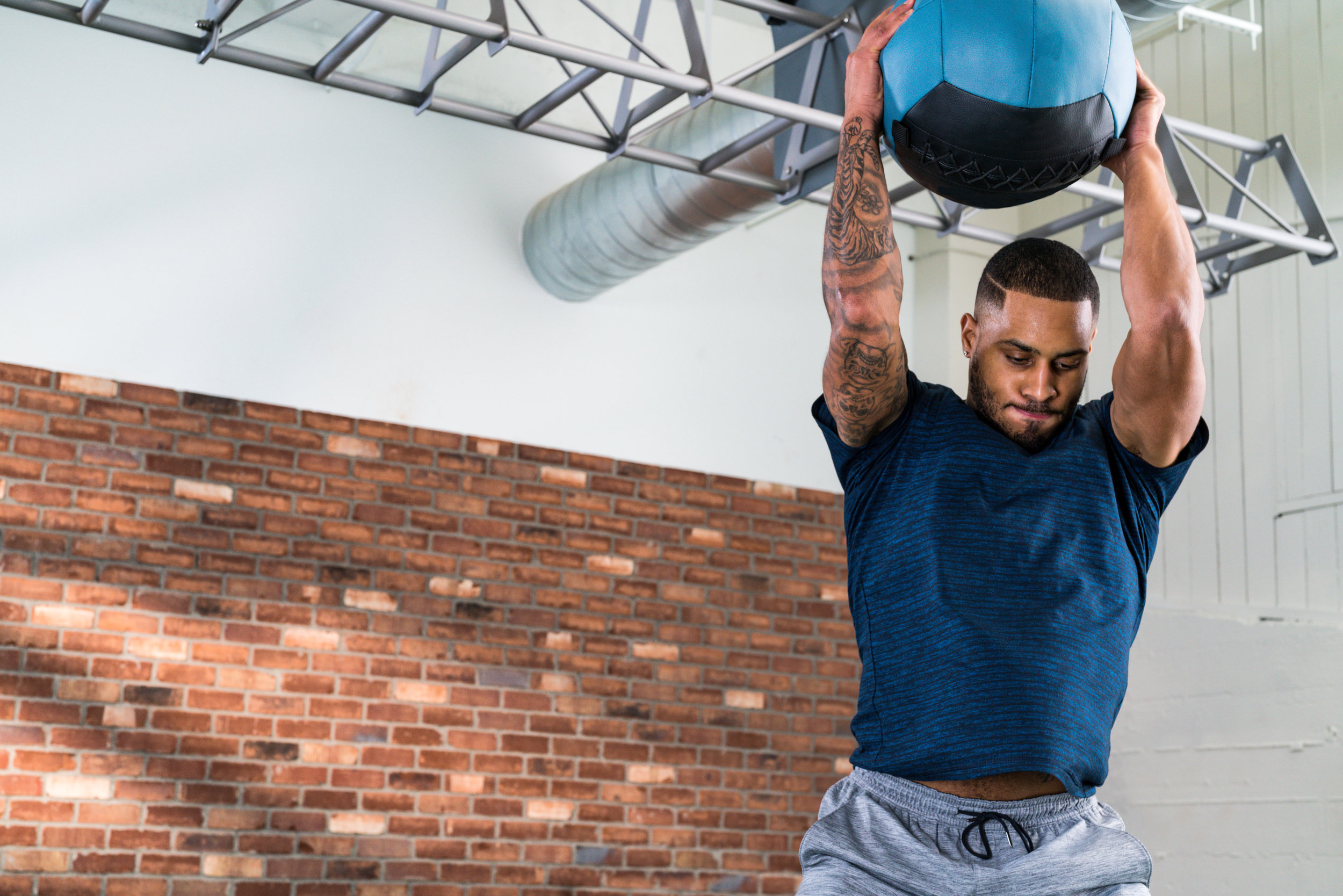
Christye Estes, CSCS, is a Sport Performance Specialist at Volt Athletics. From program design and content creation to exercise modeling, Christye has her hand in many of Volt's proverbial cookie jars. Excited about making safe strength training methods available to athletes everywhere, Christye is dedicated to researching new knowledge about strength and conditioning and finding ways to communicate it simply and effectively.
Focused on academics growing up, Christye didn't discover the love of sport and movement until late high school, when she fell in love with running. Plagued by injuries in college, she began strength training as a form of rehab — and found that when she spent time in the weight room, she could run faster, longer, and more injury-free than ever before. She became a Certified Personal Trainer through the American College of Sports Medicine in 2012, and a Certified Strength and Conditioning Specialist® (CSCS®) through the National Strength and Conditioning Association (NSCA) in 2015. Christye ran a successful personal training business before joining Volt, helping athletes and non-athletes of all ages achieve better health and performance.
Christye is passionate about helping women and girls take ownership in the weight room. And as a former English major, she also serves as Volt's grammar police, ensuring site-wide subject-verb agreement for all. Focusing on topics like mobility, anatomy/physiology, biomechanics, and female sports psychology, Christye nerds out on topics like acute:chronic workload ratios and energy system development. When she's not running, squatting, or cussing out her foam roller, Christye loves eating pizza, playing ultimate with the Volt crew, and cheering for Russell Wilson forever and always.
Coach Christye's Posts
The psoas is, quite literally, the "filet mignon" of the human body. As your primary hip flexor, the psoas works to help you run, sprint, and even walk—and it is critical to keep this muscle happy. When the psoas is either too short or overstretched, it can throw off your body's mechanics and put you at real risk of injury. Learn how to diagnose and treat your "filet mignon" muscle in this week's post.
If you’re new to the #VoltFamily—get ready! You’re about to see what working out with a personalized, adaptive, and ever-evolving training plan can do for your body (and your fitness goals). The Volt app was designed to deliver the most effective training methodology, through a powerful, patent-pending technology called Smart Sets that adjusts each workout to optimize your results. So before you tap that Start Workout button for the first time, here’s what you need to know.
Despite a well-recognized need for strength and power development (and injury prevention) in baseball, some coaches are still hesitant when it comes to the weight room—never allowing players to bench press, for example, or only utilizing bands as resistance. That’s what makes properly designed baseball strength and conditioning plan so important. Here are our top 3 reasons why baseball athletes need to strength train, and what a good baseball-specific program should look like.
For athletes, "going hard" is usually pretty easy. Whether it's a heavy lift or tough conditioning session, most athletes will face difficult challenges head-on and attack them with gusto. So then why is it so hard to get athletes to "go easy" on recovery days? Coach Christye shares an easy analogy to help your athletes understand the importance of recovery-focused training sessions, and explains why "sweat equity" culture can actually hinder performance.
Strength training is important for athletes across all sports—but for football players, it’s a prerequisite for safe competition. Read on to learn the 3 biggest benefits of a football-specific strength & conditioning plan for your athletes.
Providing quality strength and conditioning to an entire athletic department is no easy feat. Unfortunately, many departments take a uniform approach, either giving all athletes the same program or prioritizing just one sport. But we believe a unified approach, one that gives all athletes access to appropriate training for their sport or sports, is the best way to help your athletes stay healthy, perform better, and thrive. Read on to learn 3 reasons why all athletic directors should take a unified approach to strength and conditioning for their athletes.
One of the coolest features of Volt's intelligent technology is our dynamic periodized training calendar. It automatically optimizes your team's training program to your season dates, allowing your athletes to reach peak physical condition at just the right time. This article will guide you through the ins and outs of setting up your training calendar to help maximize the effectiveness of your team's Volt training.
The successful implementation of your Volt training program depends on the active participation of coaches in the weight room. By being present in the weight room, you can help ensure the safety of your athletes by reinforcing proper lifting technique, while establishing a culture of support and accountability in the weight room.
While every Volt workout is uniquely designed for the demands of an athlete's sport, position, gender, strength levels, and more (within the context of a holistic year-round program), many sessions follow a similar format. This article provides a breakdown of the structure and training philosophy behind a typical Volt training session.
Since the successful implementation of Volt starts with your weight room, here is a quick guide to weight room set-up, management, safety, and more — to help you get the most out of your Volt training.
In addition to your sport-specific strength training plan, our Sport Performance team created a library of Training Extras you can use to enhance and customize your training. These routines are entirely optional — whether you choose to use them, and how you choose to implement them, is completely up to you. This article will guide you through how to use these extras to most effectively.
Athletes accustomed to feeling 100% exhausted at the end of a workout are often surprised by Volt's scientific approach to sport performance — and even more surprised when it works. This article is intended to equip you with the "whys" behind Volt's training philosophy, so you can help educate your athletes and increase their buy-in to Volt.
If you want to train athletes safely and effectively for performance, your program MUST be flexible. This is why static programs just don't work for athletes. Period. Volt Advisory Board members Patrick McHenry and Mike Nitka weigh in on the importance of a dynamic, nimble training program, and why rigid, off-the-shelf plans just don't cut it.
Testing your athletes is crucial for implementing a successful strength and conditioning program. After all, how else will you know if your program is working?! But to obtain the most accurate and objective data, there are a few important rules to follow. Coach Christye explains the 3 most important rules to remember when testing your athletes, to help you get the most out of your data.
After a tough training session, your #1 priority is to kickstart your body's recovery processes. And one of the best (and simplest!) methods to help your body make the switch from a "fight or flight" state to "rest and digest" is by taking some time to breathe.
The NCAA recently passed legislation prohibiting coaches from scheduling early morning workouts for D1 collegiate athletes. But what about high school athletes? In this article, Volt Advisory Board member and veteran high school strength coach Mike Nitka and I discuss the pros and cons of early morning training for teen athletes—and how it may be doing athletes more harm than good.
When it comes to producing the best possible athletic performance, doing more is not always better. In this installment of our new Myth-Busters series, we tackle the myth behind the "sweat equity" approach to training, and explain why sometimes less truly is more.
"Leg Day" has become a cultural obsession (and popular meme topic!) for athletes and gymgoers, but it can create some serious problems if you're training to improve performance. And yeah, this may ruffle some feathers, but here are my top 3 reasons why you should STOP doing Leg Day.
Injuries are part of the game in any sport, but especially in sports where physicality is necessary to compete, like football, lacrosse, or hockey. While some elements of contact sports are unavoidable, what can make the difference in keeping you healthy and safe for competition is to focus on reducing non-contact injuries. Avoid injuries by correcting these 3 mistakes.
We are proud to announce our latest release of updates to Volt's intelligent training app! We’ve listened to your feedback and made some pretty huge improvements to the app and added new functionality to share your accomplishments on Twitter and Facebook!
With all the hours cyclists spend on the bike, it leaves little time for other activities. But the benefits of strength training are SO significant for cyclists that it might make you rethink your training priorities. Read on to learn 3 big reasons why cyclists should be in the weight room.
In consultation with Volt Advisory Board member Justin Smith, Co-Director of Athletic Performance at the University of Vermont, we created this blog post for field hockey players everywhere. If you or someone you know is a field hockey athlete, here are 3 fantastic reasons why strength training will help you dominate your opponents—and stay strong all season long.
For runners, "training" means running. But more runners than ever are sprinting to the weight room to reap the many benefits strength training has to offer. Here are 5 big reasons all runners—from elite marathoners like Ryan Hall to weekend stroller joggers—should start strength training NOW.
Do any (or all) of these common diet mistakes sound familiar? Read on to learn why they hurt athletic performance and how you can fix them for good!
What's more effective for basketball players: double-leg or single-leg movements? Squats or lunges? A new article in the latest issue of NSCA Coach examines the research to draw some practical conclusions about sport-specific training methods for basketball athletes.
Triathletes endure some of the most grueling aerobic endurance training out there. With all those weekly hours invested in the pool, on the bike, and on the road, it’s no wonder many triathletes don’t have time for strength training. But supplementing your aerobic work with a strength training program designed specifically for triathletes can make a significant impact on your performance—and your injuries. Here’s why all triathletes, from sprint to Ironman, should get in the weight room.
Spoiler alert! Women are different than men. And while human bodies (male and female) respond similarly to strength training, there are some unique reasons why it's specifically important for women. Read on to learn 3 reasons why WOMEN should get in the weight room.
Love to squat? So do we, which is why we've created this ultimate guide to dialing in your squat. Read on to learn our top 5 most common squat errors (and how to fix them!) to bulletproof your body and add serious lbs to your 1RM.
Rugby is no joke. A high-octane collision sport spanning 80 minutes, rugby demands the size and strength of football athletes in concert with the speed and stamina of soccer players. A well-designed S&C program can go a long way toward ensuring rugby athletes are properly prepared for the game—and can help keep these tough athletes healthy and strong all season long.































Female participation in sports in America has skyrocketed since the 1970s. But what about participation in strength training programs? If you're not providing quality strength and conditioning for your female athletes, here are 3 reasons why you should. Nearly half of all Volt teams are female, so we asked some Volt coaches to share firsthand what quality training has done for their female athletes. Read on to learn more.